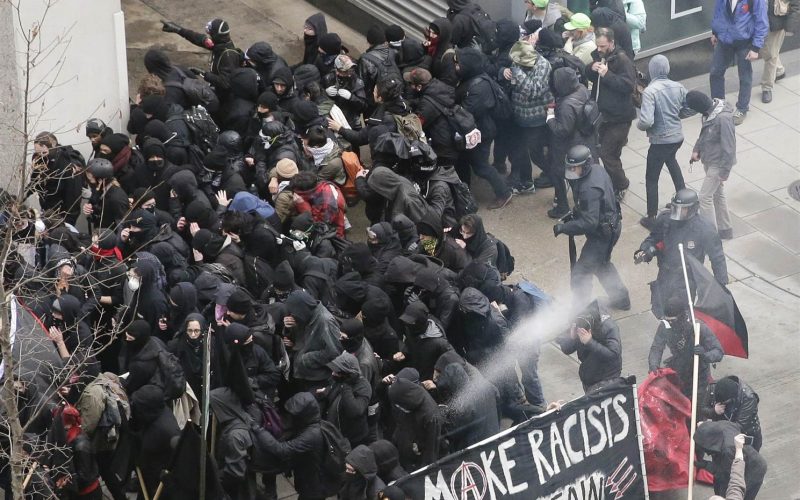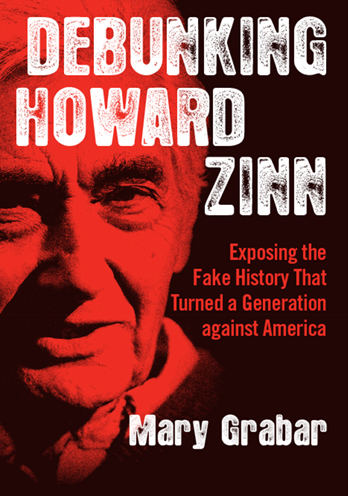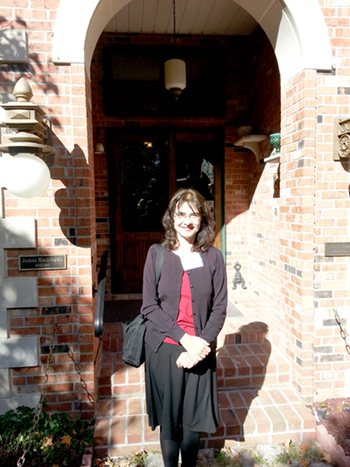 By Mary Grabar, August 28, 2017: No doubt, one of the big topics in classrooms as students come back is going to be the march of the "Nazis" and the threat to democracy by President Trump. National Public Radio, Education Week, and the National Education Association, are offering resources. USA Today had an article filled with helpful tips for teachers. Not surprisingly, these resources come from such places as the racist Southern Poverty Law Center (SPLC), the anti-Semitic Facing History and Ourselves, and the sophistic Atlantic Magazine. Read this recent "Legal Insurrection" blog post to see how SPLC is exploiting Charlottesville to further enrich themselves.
By Mary Grabar, August 28, 2017: No doubt, one of the big topics in classrooms as students come back is going to be the march of the "Nazis" and the threat to democracy by President Trump. National Public Radio, Education Week, and the National Education Association, are offering resources. USA Today had an article filled with helpful tips for teachers. Not surprisingly, these resources come from such places as the racist Southern Poverty Law Center (SPLC), the anti-Semitic Facing History and Ourselves, and the sophistic Atlantic Magazine. Read this recent "Legal Insurrection" blog post to see how SPLC is exploiting Charlottesville to further enrich themselves.
The Southern Poverty Law Center, which has made its white principals wealthy, especially founder Morris Dees, through false allegations of racism, is racist. By redirecting attention from poverty in communities of color in the South, to charges of nebulous "hate," the SPLC does its part to perpetuate poverty and hatred.
The curriculum and workshops put out by Facing History and Ourselves routinely trivialize the Nazi Holocaust by equating the slightest infraction or display of insensitivity to the horrors against the Jews under Hitler.
On college campuses, activists disguised as professors are organzing students, even as they undergo orientation. They did so when their candidate lost the presidential election, as many will recall, as does Dissident Prof who was greeted with chants about "hate" in the village square of Clinton by the snowflakes bussed down from campus. (They walked down the hill from campus, but not up.)
So the ever-reliable Chronicle of Higher Education (which hardly ever discusses issues concerning education), provided college administrators helpful tips in an article titled "University Leaders Should Plan for Another Year of Campus-Speech Protests. Here's How." The article leads with the sentence, "When polarizing speakers come to campus, there's no way to guarantee violence won't ensue." Notice, dear readers (and students), how the issue is framed. Notice the passive construction of the sentence. The blame implicitly is put on the speakers who are "polarizing." How do we determine what is "polarizing"? Why those who inspire protests. It's what we call circular logic. As we all know from last year, such speakers have names like Charles Murray and Heather Mac Donald, both in reality mild-mannered scholars (the latter I know from personal interaction) who present a lot of statistics on important topics such as the lag in educational achievement and crime in black neighborhoods. Oooh, but to speak of such things is ra-cisssst. Better to simply let gangs slaughter innocent little girls doing homework than to speak of such matters. If such slaughter were to end just imagine how many professors specializing in the "schools-to-prison-industrial-complex" research would be out of work.
For those surprised by what happened in Charlottesville recently when a motley and idiotic band of white supremacists decided to march through town and one of their obviously disturbed individuals decided to retaliate against the anti-hate counterprotestors who were assaulting them (sadly killing one woman), should not be. Campuses have been scouring their pasts for any relationship to slavery or discrimination for years now. As University of Viriginia President Teresa Sullivan told interviewers, such "conversations" about removing statues have been going on since 2013. (Such "conversations" require hours and hours of meetings, so account for pages and pages of "service work" for professors striving to attain advancement.)
No one bothers to ask the custodial crew if they ever suffered from seeing such fixtures of long-dead Confederate generals on a daily basis.
Still, the Mob is wielding power and the Confederate statues (and portraits) are coming down on campuses across the Southland. Inside Higher Ed, today, offers a "round-up" of such activity.
All the hullabaloo is to disguise the fact that most professors agitating for such removals are woefully ignorant of history. For a real historical perspective, please read AHI Senior Fellow Lee Cheek's articles and interviews, accessible through the website of the Alexander Hamilton Institute for the Study of Western Civilization (also the place where the Dissident Prof makes her home).
And since teachers will be teaching about how to spot "fake news," let's have a lesson on New York Times spin. This newspaper, in an article "trending" on Facebook, took Wall Street Journal editor Gerard Baker to task for telling his reporters to refrain from "commentary" when reporting on President Trump. In a memo, he asked reporters to "'stick to reporting what he said rather than packaging it in exegesis and selective criticism.'"
The final edits were presented. The Times saw the removal of the reporter's comment that the Charlottesville protests were "reshaping" Trump's presidency as a sign that the Journal was going "soft" on Trump. So was the description of the speech as "'an off-script return to campaign form' in which the president 'pivoted away from remarks a day earlier in which he had solemnly called for unity."
The New York Times' idea of fair coverage can be seen in their article about the speech in Phoenix:
PHOENIX — President Trump, stung by days of criticism that he sowed racial division in the United States after deadly clashes in Charlottesville, Va., accused the news media on Tuesday of misrepresenting what he insisted was his prompt, unequivocal condemnation of bigotry and hatred.
After declaring, “What happened in Charlottesville strikes at the core of America,” Mr. Trump delivered a lengthy, aggrieved defense of his statements after the Aug. 12 violence that left one woman dead and the nation reeling at the images of swastikas in Thomas Jefferson’s hometown.
Notably, he omitted blaming 'both sides' for the violence as he had on Aug. 15. Those remarks had prompted intense criticism, including from fellow Republican leaders, for seeming to equate the hate groups and the protesters who turned out to oppose them.
Now if the Dissident Prof were still teaching in our institutions of higher learning, she might include such an article for a lesson on rhetoric.
To begin, the President was "stung by days of criticism." Really? How do they know he was "stung"? Did anyone interview him about how he felt? To all appearances, he was not stung at all, but justifiably angered by reporters overlooking the violence perpetruated by masked, weapon-yielding counter-protestors.
Notice the hint of skepticism by reference to "what he insisted" was his condemnation of hatred and bigotry. Are the quotation marks there to support the notion that we should doubt what he said? How about a link to his actual words?
Trump's speech was "a lengthy, aggrieved defense of his statements after the Aug. 12 violence that left one woman dead and the nation reeling at the images of swastikas in Thomas Jefferson's hometown."
The "nation reeling"? Really? Where do they get this information? No one was "reeling" around me. How about you?
And "notably" President Trump refrained from referring to "both sides" because we know that even when we have footage and first-hand reports of violence by "counter-protestors" that that is justified violence. It was justified in March 2016 against ordinary Americans going to a campaign rally in Chicago. In these reporters' minds it is all the more justified because a few dozen kooks decide to sport swastikas. Violence is justified by the actions, symbols, or presence or political opponents, in other words. Therefore, it is not really violence, so the President was wrong to say that both sides were violent.
It gets even better. Times reporters dig up rarely used adjectives to report "the facts." Like this:
In an angry, unbridled and unscripted performance that rivaled the most sulfurous rallies of his presidential campaign, Mr. Trump sought to deflect the anger toward him against the news media, suggesting that they, not he, were responsible for deepening divisions in the country.
If real teaching were going on, you'd have rhetorical analyses of such spin by normally atheistic New York Times reporters conjuing up images of hell. You'd also have students reading George Orwell.





